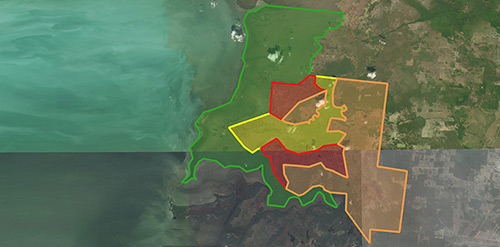Sabancuy Project Overview
The blue carbon project called El Diamanté Azul de Sabancuy is a mangrove conservation and restoration project consisting of more than 15 thousand hectares of mangrove wetlands located in the Sabancuy Estuary in the state of Campeche, Mexico. Mangrove species within the project area include Rhizophora mangle (red mangrove), Avicennia germinans (black mangrove), Laguncularia racemosa (white mangrove) and Conocarpus erectus (buttonwood mangrove). The project area is part of the southwest Campeche flood plain and the estuary communicates with the northeast portion of Laguna de Términos complex. The hydrology consists of numerous flooded lowlands and high soluble salts content, as well as lagoons and wetlands. Mangrove degradation is a problem due to illegal logging and burning to make way for pasture lands. Without the project and planned activities, the mangroves will continue to be degraded and deforested.
The project’s conservation and restoration activities will be conducted entirely by local community members and will be trained by an experienced local cooperative managed by women. The project leadership will include local community members as well as financial benefit streams will flow directly to more than 500 local community families. Local community participation in the restoration and reforestation of 2,211 hectares of degraded mangrove area will provide incentive (year round work in restoration activities) for the locals to preserve and protect the mangroves. In addition to the direct employment, the environmental services that will be provided by the ecosystem once recovered will include quality of habitat for fish and birds, improved water quality, as well as sequestration of more than 7.4 million tCO2e over the life of the project. From the 13,542 Ha of pristine mangroves, another 4.9 million tCO2e in avoided emissions will be prevented due to the conservation activities over the life of the project.
The project currently achieves sustainable development goals 1, 2, 5, 8, 11, 13, 14 and 15 and we hope to reach many more once the social impact programs are rolled out and operating. The project will provide social impact programs to over 9,000 community members living in and around the project area. The community development programs will include but are not limited to providing medical and dental assistance, education programs that include classroom upgrades and computers, supporting and building local libraries, trash recycling programs, raised bed vegetable farming, and supporting microbusiness enterprise such as sustainable cattle ranching programs, sustainable fishing programs, honey production, eco-tourism, sports fishing for tourists (catch and release), and many more programs.
Relevant ecosystem services provided beyond carbon include ecotourism, local fishing for food, commercial fishing, and production of honey. The area is biologically rich, where 15 vegetative associations, with a total of 374 species are found. Threatened floral species found the area includes the Bletia purpurea, Bravaisia integerrima, B. tublifora. Endangered flora species found include the orchid Habenaria bractescens. Fauna estimates suggest that there are at least 1,468 species, both terrestrial and aquatic. Studies have found that the largest populations of the endangered jaguars (Panthera onca) are found in the Sabancuy area and around Laguna de Terminos, as well as the American crocodile (Cocodrylus acutus) and Morelet’s crocodile (C. Moreletii). The hawksbill turtle (Eretmochelys imbricata), green turtle (Chelonia midas) and Kemp’s Ridley turtle (Lepidochelys kempi) also found in the area are under special protection. Lastly, preserving urban wetlands in good condition, contribute to making cities and towns safer from the manifestations of climate change.
Project Area Highlights:
- 14,883 Ha Mangrove
- 11,883 Ha Conservation
- 3,000 Ha Restoration
- 2,150,000 tCO2 Avoided
- 6,035,000 tCO2 Sequestered

Sustainable Development Goals (SDGs) and Impacts
For a full list and explanation of each SDG, click here
